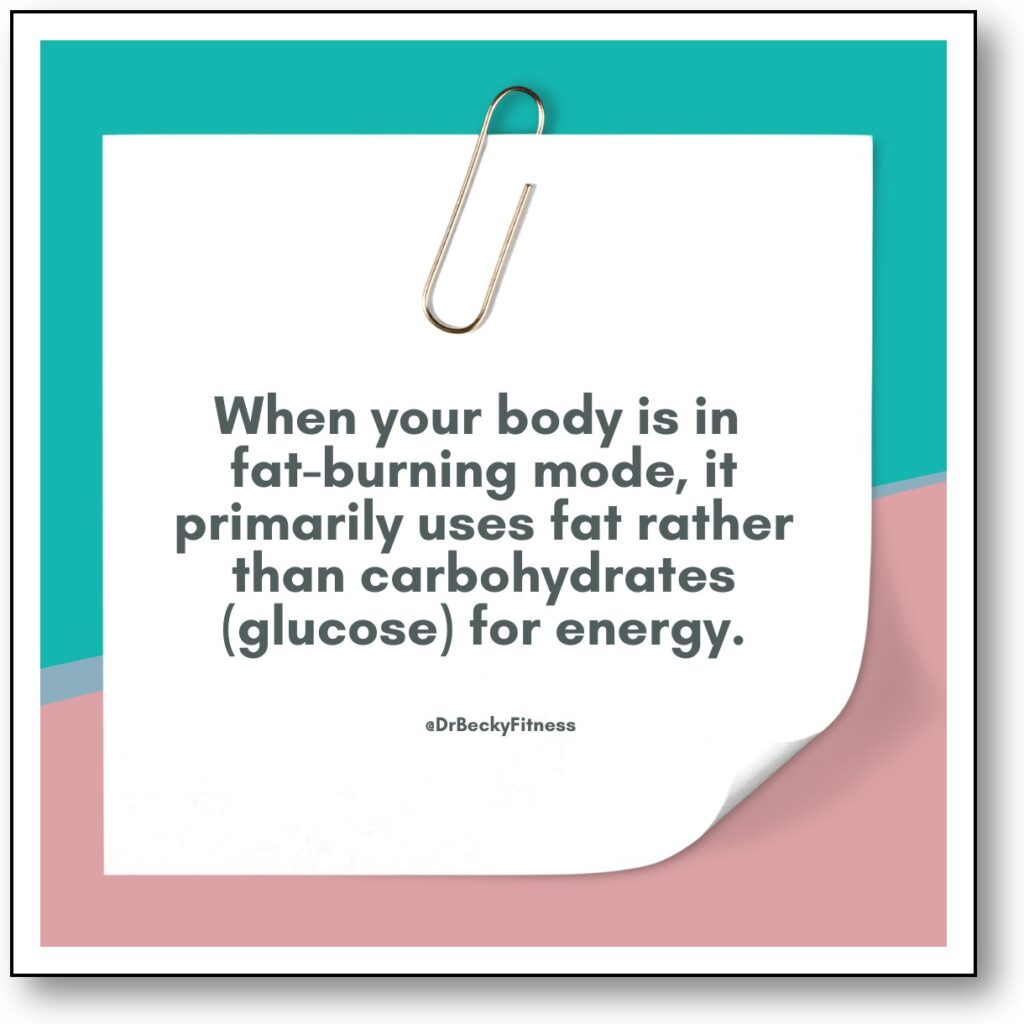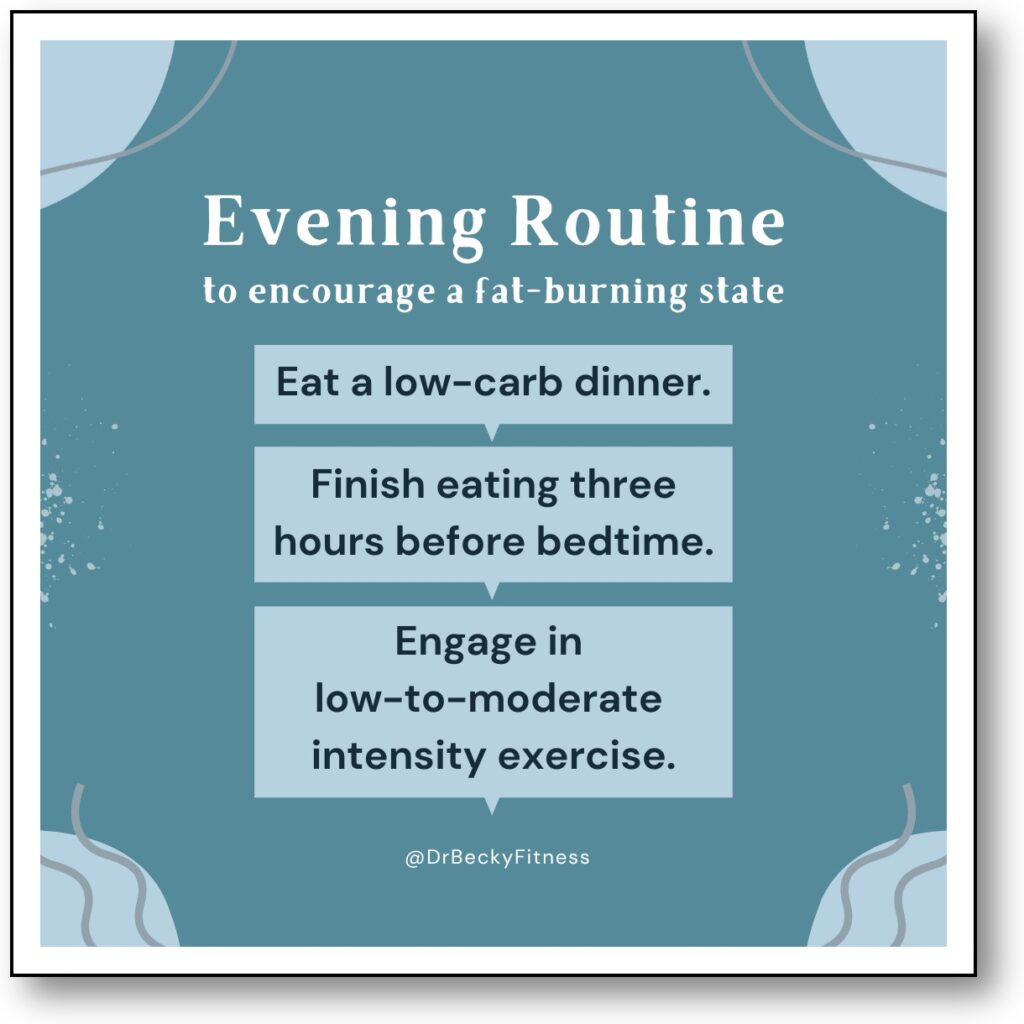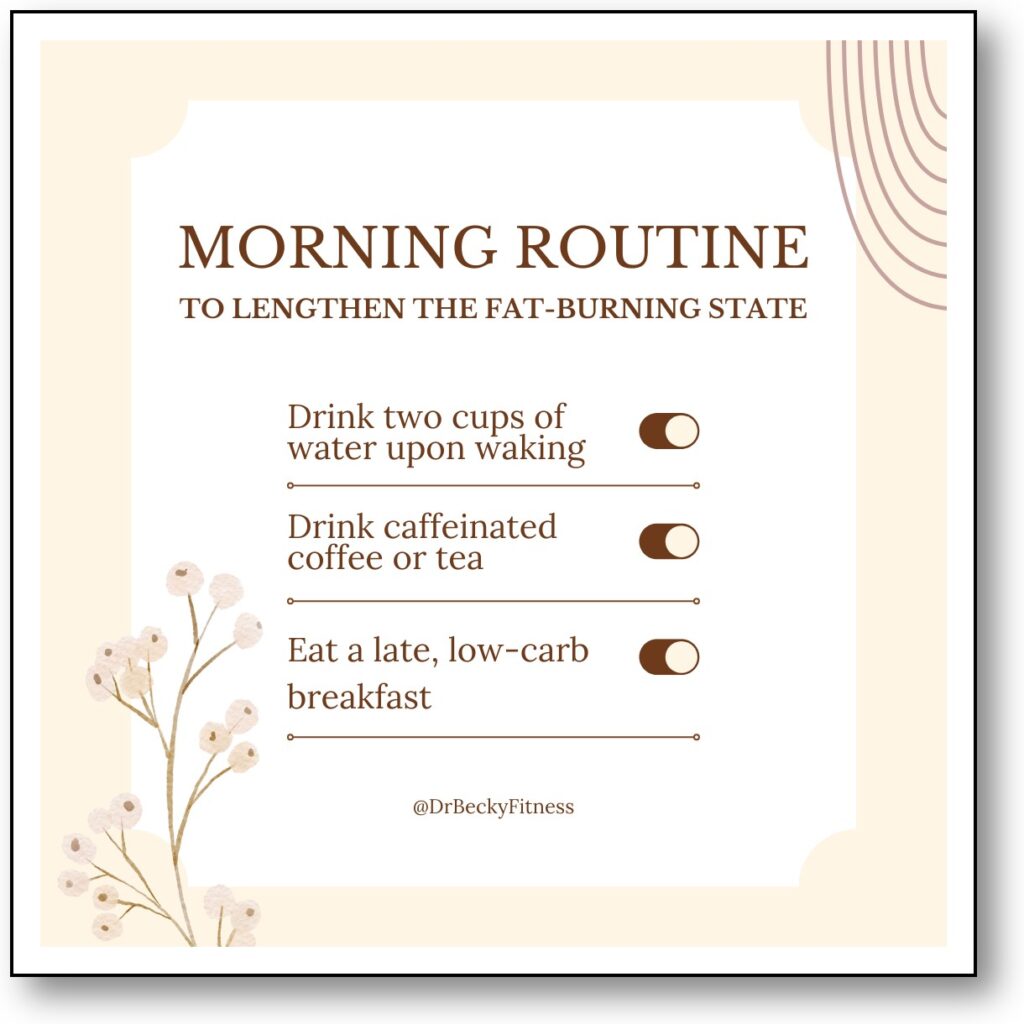
Wake Up in Fat-Burning Mode: The Morning and Evening Routines That Work While You Sleep
Video | Evening Routine | Morning Routine
Waking up in fat-burning mode means your body is primarily using fat, rather than carbohydrates (glucose), as its main source of energy when you start your day.
An obvious perk of being in this mode is that your metabolism is more efficient at tapping into stored body fat for fuel, which can support weight loss. However, there are other advantages, including steady energy levels and mental clarity.
These effects are things you want every day, not just when you are trying to hammer out a goal, so this blog post is going to share easy-to-follow, enjoyable, and effective routines that you can comfortably do every day.
Fat-Burning Mode At-A-Glance
- When your body is in fat-burning mode, it primarily uses fat rather than carbohydrates (glucose) for energy.
- An evening routine to encourage a fat-burning state includes eating a low-carb dinner, finishing eating three hours before bedtime, and engaging in low-to-moderate intensity exercise, such as a brisk 30-minute walk.
- A morning routine to lengthen the fat-burning state includes drinking two cups of water upon waking, drinking caffeinated coffee or tea, and eating a late, low-carb breakfast.
Wake Up in Fat-Burning Mode: The Morning and Evening Routines That Work While You Sleep [Video]
In this video, you’ll learn…
- The advantages of waking up in fat burning mode.
- A morning and evening routine that will put your body in a fat-burning state.
- Additional tips and resources within each routine.

Set Up Fat-Burning Overnight
I am going to walk you through routines that start in the evening and end in the morning because those periods are the most important for what we’re trying to accomplish in this post.
That does not mean that the afternoon should be ignored or handled as a free-for-all where anything goes. That is an invitation to self-sabotage.
As I mentioned, we want these routines to be easy to carry out because when things are easy, enjoyable, and effective, we keep doing them. With that said, let’s get into the evening routine.
Evening Routine
Overnight, your body enters a natural fasting state, but it doesn’t stop using energy. Whether that energy comes from stored fat or glycogen, which is stored glucose, has a lot to do with how you handle dinner.
Limit Carbs at Dinner
A low-carb dinner helps keep glucose low. When it is not readily available, stored fat has to step up as the main fuel source. Fortunately, our bodies flip this switch for us as we sleep.
Your evening meal should prioritize protein (meat, chicken, salmon, eggs), non-starchy vegetables (broccoli, green beans, zucchini), and healthy fats (olive or avocado oil, avocados, cheese, nuts).
These foods help stabilize blood sugar, reduce insulin spikes, and lay the foundation for overnight fat metabolism. It also helps to eat your dinner early in the evening.
Eat Early
Late-night eating keeps your blood sugar and insulin levels elevated, making it hard for your body to flip the switch to fat-burning.
Typically, blood sugar peaks within two hours after eating a meal and then returns to a premeal level in about three hours. The target is to be finished eating three hours before bed.
If you get too hungry so that you cannot sleep, try cheese with apple cider vinegar or cheese alone.
In a past blog post, I highlighted a study showing that eating an early dinner and consuming 30ml or two tablespoons of apple cider vinegar with an ounce of cheese before bed helped control morning blood sugar levels in diabetic patients (1).
The cheese was used to make the vinegar more palatable, yet you would think that it would negate the benefits because you’re eating at night. That was not the case. In fact, there was a control group that had no apple cider vinegar; they just ate cheese before bed and still woke up to better morning blood sugar levels.
Now, this was a small study, so don’t take it as the gospel truth, but if you are so hungry at night that you cannot fall asleep, an ounce of cheese is worth trying, and if you are so inclined, you can pair it with two tablespoons of apple cider vinegar.
Low-to-Moderate Intensity Evening Exercise
Exercise also lowers blood sugar, and it does it without insulin. Typically, after a meal, your body needs to release insulin to get glucose into your cells. Exercise allows muscle tissue to absorb glucose without insulin.
Low-to-moderate-intensity activities, like brisk walking, are good choices for stabilizing post-meal blood sugar levels because they primarily use glucose for energy without triggering a significant stress response, like we see with high-intensity exercise.
Therefore, to nudge your body toward overnight fat-burning, it helps to take a brisk walk after dinner. Ideally, aim for 30 minutes, but even a 10 to 15-minute walk is helpful.

Morning Routine:
The evening routine we just discussed allows your body to shift to fat-burning overnight. When you wake up in a fat-burning state, you want to keep it going. An easy first step is water.
Drink Water First Thing
Recently, my husband and I shared a study showing that drinking 500 ml, or about two cups, of water first thing in the morning increases energy expenditure by 24% over the course of the next hour (2).
A one-hour metabolic boost may not sound like much, but it is easy to do, and again, when things are easy and effective, we keep doing them. I do this every morning. I stand at my sink, fill a cup with filtered tap water, drink it, and then have a second cup. I then have a cup or two of black coffee.
Drink Coffee or Tea
Caffeine from coffee or tea can boost the metabolic rate and increase fat burning. However, we build a tolerance to caffeine over time, so this effect is diminished in regular coffee drinkers like me. But I still find drinking coffee beneficial because it is satisfying and enjoyable, and it suppresses false hunger signals, allowing me to delay breakfast.
Delay Breakfast
Stretching your fast into the morning allows you to benefit longer from your early dinner. With no food coming in, insulin levels remain low, and your fat-burning time is extended. You can stretch those results even further by limiting carbs in your first meal of the day.
Avoid Refined-Carb at Breakfast
Carbs are an easier energy source than fat. When you eat carbs, your body runs on them, kicking you out of fat-burning mode.
Eggs are a great low-carb choice for balancing blood sugar and lengthening the fat-burning state, but if you’re tired of eggs, you can try full-fat yogurt, chia pudding, or just eat meat and cheese. I presented these three blood sugar balancing breakfast recipes in an earlier blog post and tested them wearing a CGM. Each one kept my blood sugar stable.

Takeaway
When you have an easy-to-follow, enjoyable, and effective routine, you can wake up in fat-burning mode every morning.
Start tonight by eating a low-carb dinner and time it so you are done eating three hours before bed. After dinner, go for a brisk walk. Even 10 to 15 minutes will add value. When you wake up in the morning, drink two cups of water, enjoy a cup or two of coffee, and eat a late low-carb breakfast.
This is not an extreme diet and exercise routine, yet it will encourage weight loss and enhance energy and mental clarity.
References:
(1) White, Andrea M., and Carol S. Johnston. “Vinegar ingestion at bedtime moderates waking glucose concentrations in adults with well-controlled type 2 diabetes.” Diabetes care 30.11 (2007): 2814-2815.
(2) Boschmann, Michael, et al. “Water drinking induces thermogenesis through osmosensitive mechanisms.” The Journal of clinical endocrinology and metabolism 92.8 (2007): 3334-3337.
About the Author
Becky Gillaspy, DC, is the author of The Intermittent Fasting Guide and Cookbook and Zero Sugar / One Month. She graduated Summa Cum Laude with research honors from Palmer College of Chiropractic in 1991.



